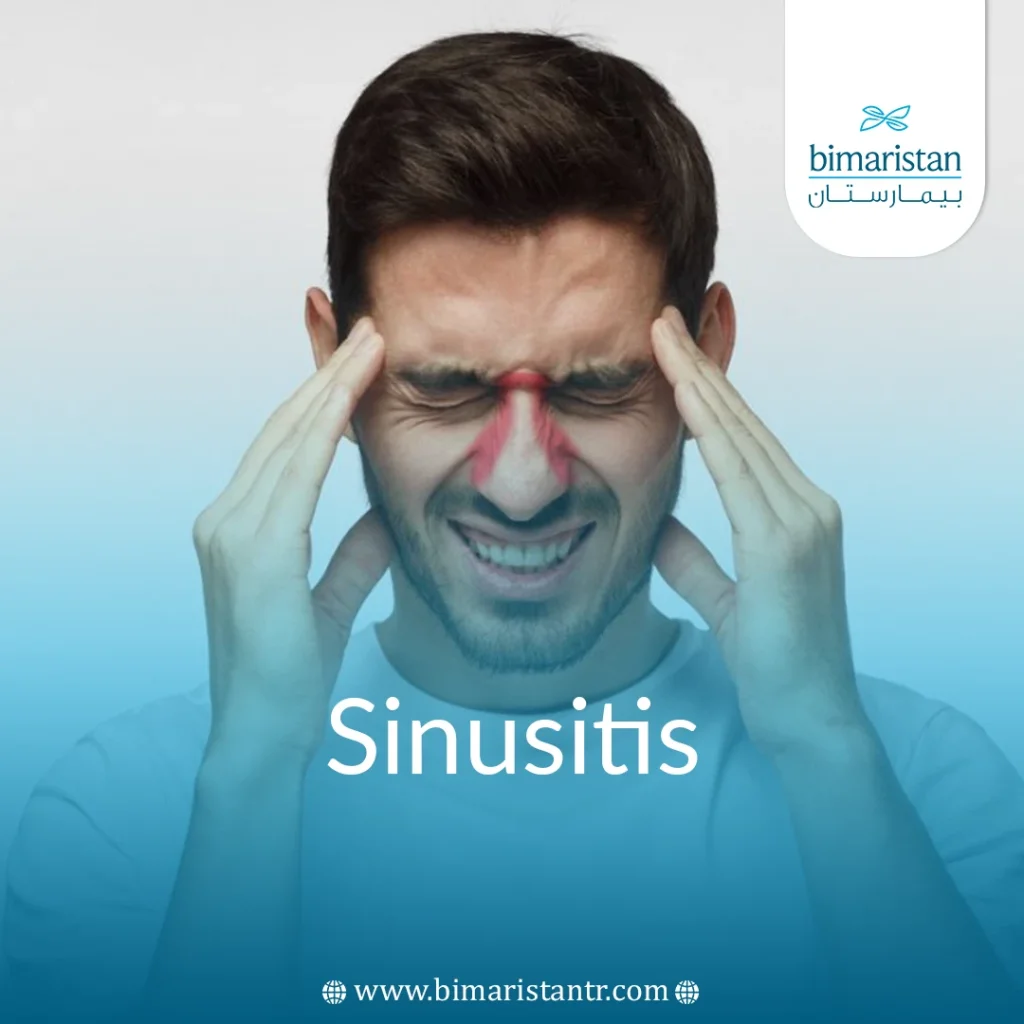Sinusitis is a common condition that may cause severe pain and headaches for some people due to viral or other causes. Several modern methods, including surgery, are used to treat it in Turkey.
Most cases of sinusitis are caused by a virus and disappear on their own after a while. Viral sinusitis is contagious, so the infected person must take appropriate steps to avoid transmitting it to others.
Most patients ignore this condition as unimportant, but it may cause severe pain for some people due to inflammation of the membranes lining the sinuses in the skull.
What are the sinuses?
The sinuses are cavities in the skull, between the eyes, behind the cheekbones, and in the forehead. These sinuses have openings that connect them to the nose. These cavities help make the skull lighter and allow the air entering through the nose to warm up. The sinuses are also responsible for determining a person’s voice, which changes with the vibrations of the air inside the sinuses.
The lining of these sinuses is the same as that of the nose. The sinuses produce a sticky secretion called mucus. This mucus keeps the nasal passages moist, which helps protect against dust, allergens, and pollutants.
The sinuses in the skull include:
Frontal sinuses
They are located in the frontal bone with a sinus on each side behind each brow bone. The sinuses are rarely symmetrical, as the septum separating the frontal sinuses always tilts toward one of them. The frontal sinus opens through the frontonasal canal into the ethmoid funnel, which opens into the semilunar hiatus in the middle nasal meatus.
Sphenoid sinus
It is the only single sinus in the head, located within the body of the sphenoid bone, which is slightly deep in the skull and is located near the optic nerve and the pituitary gland in the brain. The sphenoid sinus opens into the sphenoethmoid recess through an opening in the anterior wall of the sinus. Its size is variable, as it can extend into the pterygoid process’s root, the sphenoid bone’s greater wing, and the occipital bone’s basal part.
Ethmoid sinuses
It consists of a group of small cavities called ethmoid cells located within the ethmoid labyrinth. The cells of the ethmoid sinuses are divided according to their location into three sections:
- The anterior ethmoid cells, which form the anterior part of the ethmoid sinus cavities, are excavated within the ethmoid labyrinth. The anterior ethmoid cells open into the ethmoid funnel, which opens into the anterior part of the semilunar hiatus, a crescent-shaped groove in the lateral wall of the middle nasal meatus.
- The middle ethmoid cells are a group of cavities that form the middle portion of the ethmoid sinus. The middle ethmoid cells project into the nasal cavity to form a protrusion in the lateral wall of the middle nasal meatus called the ethmoid bulla. The middle ethmoid cells open into or near the bulla.
- The posterior ethmoid cells are a group of small cavities. These cavities open into the nasal cavity via the superior nasal meatus.
Maxillary sinuses
They are large and located behind the cheekbones on either side of the nose. They are pyramid-shaped and are considered the largest sinuses in the head.
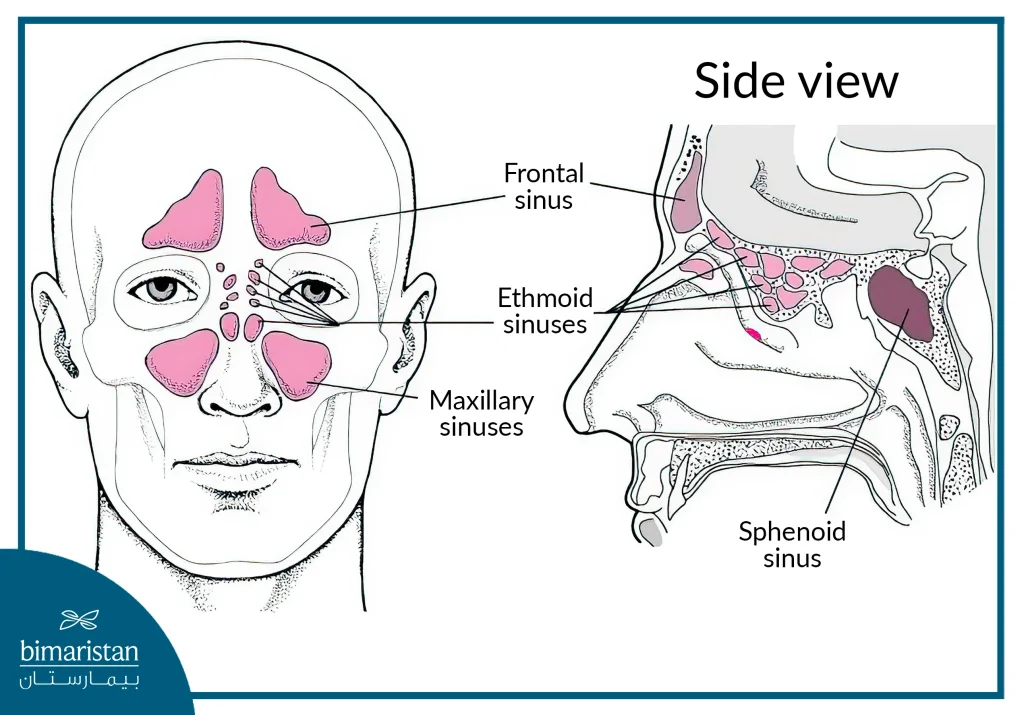
What is sinusitis
Sinusitis is an inflammation or swelling of the membrane lining the sinuses.
Normal sinuses are filled with air, but when they become blocked and filled with mucus, germs can grow and cause infection.
Causes of sinusitis include viruses, bacteria, fungi, allergies, and autoimmune reactions.
Although sinus infections are painful and annoying, they often disappear without medical intervention. However, the patient should consult a doctor if symptoms are severe and persistent.
Symptoms of sinusitis
Symptoms of sinusitis vary depending on how long the condition has lasted and its severity. Patients with sinusitis generally experience:
- Nasal discharge that may be yellow or green.
- Postnasal drip, where mucus flows down the throat.
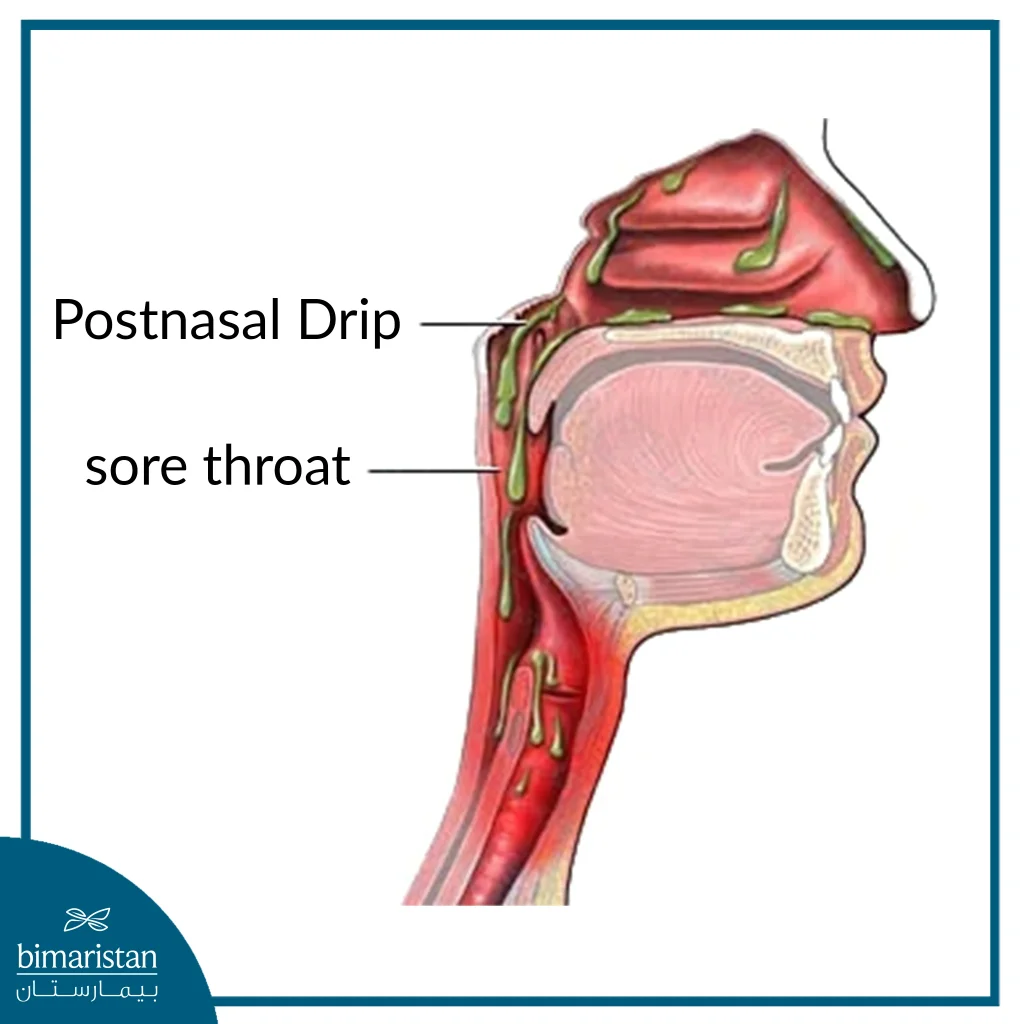
- Pain and pressure in the face.
- Stuffy or runny nose.
- Sore throat.
- Bad breath.
- Fever and cough.
- Decreased sense of smell and taste.
- Pain and swelling around the eyes, nose, cheeks, and forehead.
Causes of sinusitis
Several factors can cause sinusitis, but it always involves fluid retention in the sinuses, allowing germs to grow and multiply.
The most common cause is viruses, but bacterial infections can also lead to sinusitis. Some factors irritate sinusitis, such as allergies and asthma, as well as pollutants in the air, such as chemicals.
Fungal infections can be the cause of fungal sinusitis.
Factors that increase the risk of sinusitis
- Having a previous respiratory infection, such as a cold.
- Nasal polyps, which are small benign growths in the nasal passage that can lead to blockage and inflammation.
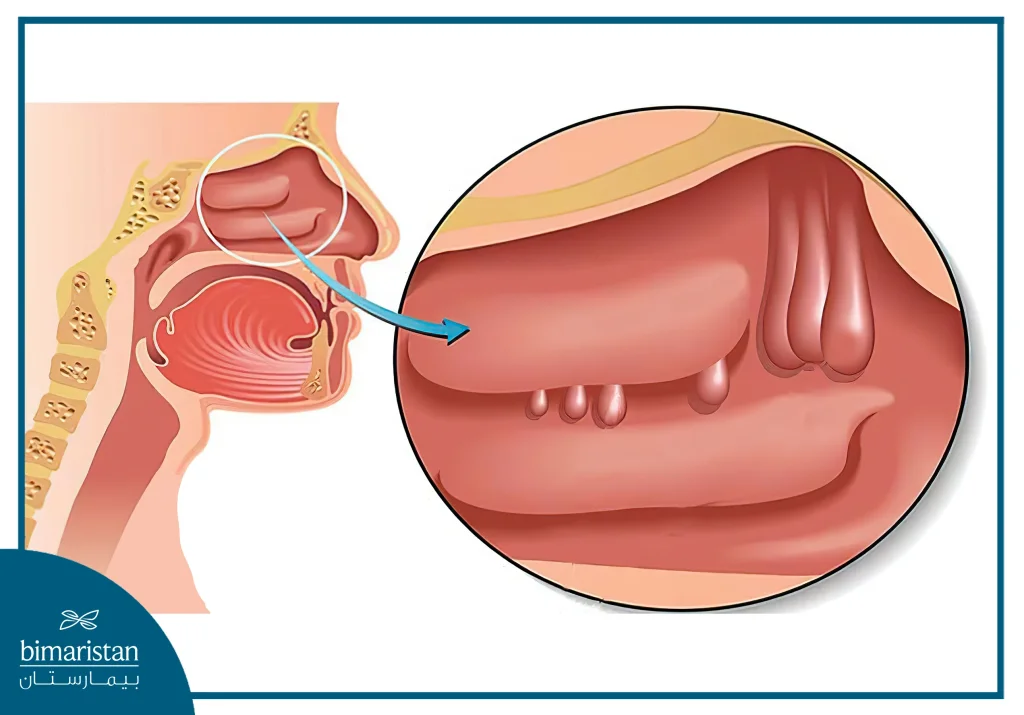
- Seasonal allergies.
- Allergies to substances such as dust, pollen, and animal hair.
- Weakened immune system due to a medication or health condition.
- Deviated septum, the bone and cartilage partition that divides the nose into two nostrils. When this septum is tilted to one side, either through an accident or as it grows, it can increase the risk of sinusitis.
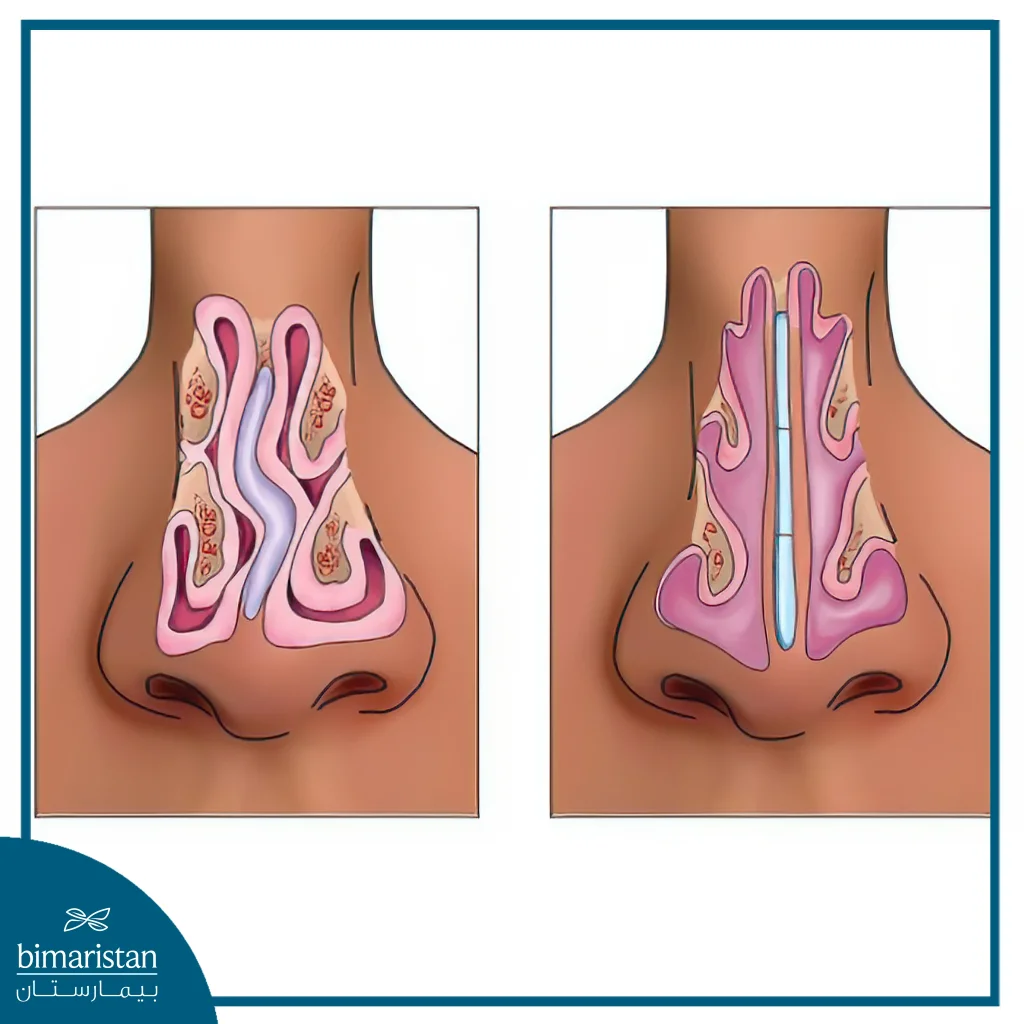
Types of Sinusitis
There are two types of sinusitis, which generally differ from each other in the length of time the condition lasts and the recovery and treatment time depends on the type of inflammation, which are:
Acute sinusitis
A temporary inflammation can occur when a person suffers from a cold or seasonal allergies. Symptoms usually go away within 7-10 days but can last up to 4 weeks.
When suffering from acute sinusitis, it may be difficult to breathe through the nose. The patient may feel swelling in the area around the eyes, a throbbing pain in the face, or a headache.
Chronic sinusitis
Also called chronic rhinosinusitis, chronic sinusitis occurs when symptoms last for more than 12 weeks or recur three times within one year.
Studies have shown that more than 50% of people with moderate to severe asthma also suffer from chronic sinusitis.
When should you see a doctor?
Home remedies are usually enough to help with recovery. However, you should see a doctor if your symptoms:
- It lasted more than 10 days without getting better.
- Include severe symptoms that don’t go away with over-the-counter medications.
- Include changes in vision or swelling around the eyes.
- Worsen after a period of improvement.
- Include a fever that lasts more than 3-4 days or is higher than 101.5 degrees Fahrenheit (38.6 degrees Celsius).
There may be other symptoms; if the symptoms are concerning, seek medical help immediately.
Diagnosing Sinusitis
A doctor can make a diagnosis by:
- Asking about your symptoms.
- Performing a physical exam.
- Use an endoscope to examine your nasal passages and sinuses.
- An MRI or CT scan is performed to check for structural problems.
- Performing allergy tests to identify possible triggers.
Home remedies for sinusitis
In about 70% of cases, acute sinusitis resolves without a prescription.
Various home remedies and over-the-counter medications can relieve symptoms.
Examples of these treatments and medications include:
- Nasal irrigation involves washing the nasal cavity to flush out excess mucus from the nose and sinuses. Nasal irrigation, in a broader sense, also refers to the use of a saline nasal spray or spray to moisten the mucous membranes. A neti pot is one way to do this, a container designed to rinse and clean the nasal cavity of waste or mucus. A neti pot may be used to treat nasal allergies, nasal problems, or colds.
- Sleep or rest with your head and shoulders comfortably supported on a soft pillow, with the side of your face free of pain on the pillow.
- Warm compresses: Gently apply to affected areas to reduce swelling.
- Pain relievers: Acetaminophen or ibuprofen can reduce pain and fever.
- Steam inhalation: Place a hot, damp towel on your face or inhale steam directly from a bowl of hot water.
- Essential oils: These are compounds extracted from plants and represent the essence of the plant. Adding a few drops of menthol or eucalyptus oil to hot water or a towel may help, but be careful not to swallow or apply them directly to the skin.
Antihistamines, such as cetirizine (Zyrtec) and loratadine (Claritin), are usually unsuitable, as they can cause the mucus to harden, worsening symptoms.
Your doctor or pharmacist can advise you on these options and how to use them.
Sinusitis treatment in Turkey
Treatment options depend on the type of inflammation, which mainly depends on how long the condition has lasted.
Acute and subacute sinusitis
No treatment is usually needed, but your doctor may prescribe treatment if symptoms persist or are severe.
If a bacterial infection is present, your doctor may prescribe antibiotics, but if symptoms persist after you finish the course, you should return to your doctor.
How to prevent chronic sinusitis
Bacteria do not usually cause chronic sinusitis, so antibiotics are unlikely to help.
Reducing exposure to triggers, such as dust, pollen, and other allergens, may help relieve symptoms.
Corticosteroid sprays or tablets may help control inflammation, but they often require a prescription and medical supervision, and long-term use of these medications can have harmful effects.
Sinusitis Surgery in Turkey
A doctor may recommend surgery if other treatments have not worked. This is an option for people with chronic sinusitis or with abnormal sinus structure or growth.
However, surgery may not completely solve the problem, and the patient often needs to continue other treatments after surgery to prevent sinusitis from returning again.
Sinus surgery is a procedure that aims to open the sinus passages and remove anything that obstructs the drainage paths in them. This includes removing:
- Thin pieces of bone.
- Mucous membranes.
- Nasal polyps.
- Swollen or damaged tissue.
- Tumors that block the nasal passage or sinuses.
The most common type of sinus surgery is endoscopic surgery. However, other procedures can be performed:
Functional Endoscopic Sinus Surgery (FESS)
FESS is performed using a thin tube called an endoscope. The endoscope is inserted into the nose to access the sinus openings. Tiny telescopes and surgical instruments can then be passed through and used to perform the procedure. The surgeon uses these instruments to remove obstructions that block the nasal passages.
The entire procedure is performed through the nostrils and leaves no scars. Some swelling may occur, but it goes away very quickly. Patients who have undergone this surgery usually feel discomfort for a short period of time.
FESS can be performed more than once, and it can also be performed on an outpatient basis.
Image-guided surgery (IGS)
Image-guided endoscopic surgery (IGS) is a new procedure that may be recommended for severe forms of sinus obstruction.
CT scans and infrared light help the surgeon identify anatomical structures and remove as little nasal tissue as possible. This guidance allows the surgeon to navigate the sinus passages and remove tissue and other obstructions with precision.
Caldwell-Luc procedure
This is a less common and more invasive procedure performed when abnormal growth occurs within the sinus. It aims to create a way for the sinus secretions to drain out.
The surgeon makes an incision in the upper jaw, above the second molar, and enters the sinus cavity through this incision. This surgery is performed under local or general anesthesia.
In children, surgery should be a last resort, and even if your doctor recommends surgery to treat your child’s sinusitis, it may be best to get a second opinion before proceeding with this option.
Recovery after surgery
Depending on the type of surgery and health condition, the patient can return home on the same day or the day after surgery.
The patient often feels discomfort after the operation, in addition to peeling, congestion, and slight nosebleeds, but these are normal symptoms that do not require concern and quickly disappear with adherence to the medications prescribed by the specialist in charge of the case.
The medications prescribed to the patient during the first period after surgery often include some antibiotics and nasal sprays.
To control bleeding, a small amount of gauze or bandages is placed inside the nose close to the sinuses. The gauze or bandages can be absorbable and dissolve over time, but if they are not, the doctor will have to remove them.
Depending on his health condition and age, it may take days before the patient begins to feel better. To achieve better results and avoid complications and side effects as much as possible, a set of tips must be followed during the period following the operation:
- Avoid blowing secretions from the nose (blowing the nose outward).
- Keep the mouth open as much as possible when sneezing to relieve pressure inside the sinuses.
- Raising the head while sleeping by placing an extra pillow under the head.
The patient must follow the doctor’s instructions and take all medications as prescribed in the period following surgery. In the first two weeks after surgery, the patient may have to make changes to his daily routine.
Preventing sinusitis
The following tips may help prevent sinusitis:
- Avoid smoking and passive smoking.
- Keep up with reliable, up-to-date vaccinations.
- Stay away from people with colds and other respiratory infections.
- Use humidifiers to moisten the air in the house and keep it fresh.
- Maintain and clean air conditioners regularly to prevent mold and dust from accumulating in them.
- Avoid and deal with allergens as much as possible.
The difference between allergies and sinusitis
Allergies occur when the body’s immune system overreacts to irritants and allergens, while bacteria or viruses usually cause sinusitis.
The symptoms of allergies and sinus infections can be very similar. Both conditions can cause sinus pain, pressure, runny nose, congestion, and sneezing. Allergies can sometimes lead to sinusitis, but some subtle differences can help a person know whether they have an allergic reaction or sinusitis.
It is important to get an accurate diagnosis because the treatments for allergies and sinusitis are very different.
Allergies
A person may have an allergic reaction if they have:
- Symptoms that come and go or only appear at certain times of the year.
- Symptoms that only appear in certain situations, such as going to a pet store.
- Itchy, watery eyes.
- Watery, clear, or thin nasal discharge.
- Frequent sneezing.
Signs of Sinusitis
You may have sinusitis if you experience:
- Thick, yellow, or green mucus.
- Symptoms that don’t seem to be related to specific situations.
- Pain in the gums or over the teeth.
- Bad breath.
- A feeling of intense pressure in the face.
- A decreased ability to smell or taste.
- Fever.
The prognosis for most cases of sinusitis is good. Sinus infections often go away on their own within a week or two.
When symptoms don’t go away, the infection may be bacterial, in which case antibiotics may be effective.
Although rare, fungal sinus infections can be severe and difficult to treat.
With proper medical care, most people with sinusitis recover well. However, if the infection doesn’t improve after three months, your doctor may refer you to an ear, nose, and throat specialist (ENT) who can determine and treat the underlying cause of your chronic sinusitis.
Sources:
- NIH
- Penn Medicine
- Johns Hopkins
